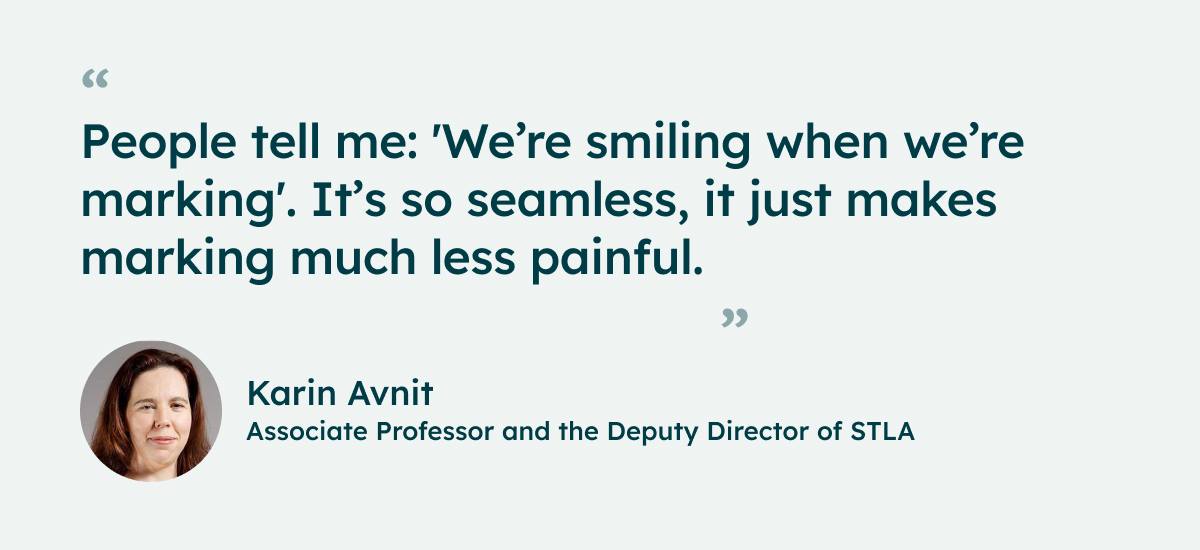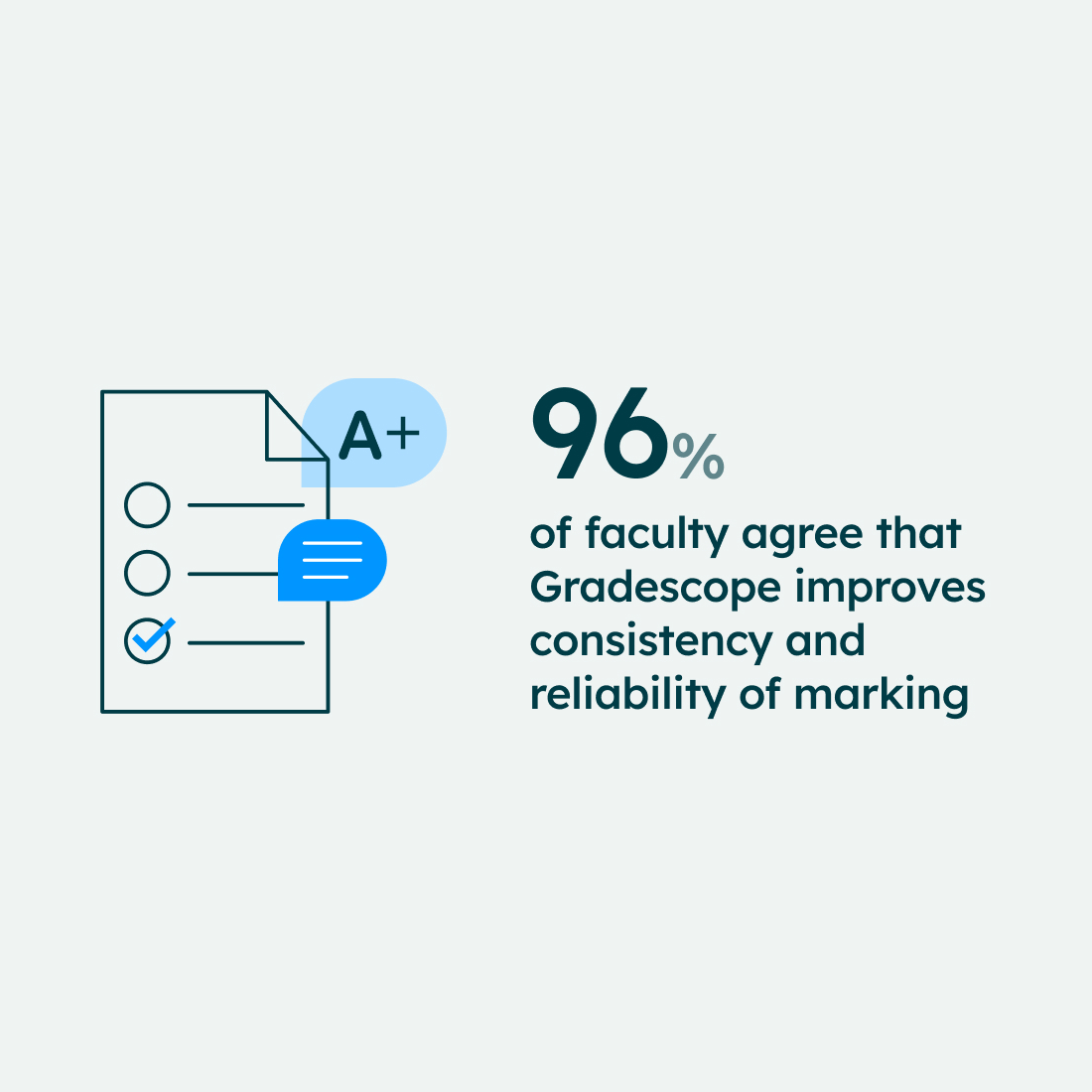Key outcomes
- Gradescope transforms how marking of paper-based assessment is conducted
- 96% of faculty agree that Gradescope improves consistency and reliability of marking
- Time spent on backward corrections has reduced from hours to a matter of minutes
- Assignment Statistics inform teaching and support students’ next steps for learning
Background
Singapore Institute of Technology aims to be a leader in innovative learning by integrating learning, industry, and community. SIT Teaching and LEarning Academy (STLA) develops the pedagogical framework and scholastic environment at SIT to enrich student engagement and learning.
Karin Avnit, an Associate Professor and the Deputy Director of STLA, regularly evaluates technological tools to enhance how their courses are run. She was particularly interested in streamlining their first-year introductory module ICT1005 - Mathematics and statistics for ICT, which consisted of 200-270 students managed by 2-5 instructors.
The unit’s pedagogical approach is based on continuous assessment to inform next steps for learning, with 50% of marks awarded from coursework assessments, and the remaining 50% determined by final exam results. Weekly activities consist of two interactive lectures to present course content, a period of self-learning followed by a readiness test, homework exercises and an active tutorial to demonstrate student learnings.
Challenge
Given the unit’s size and commitment to formative and summative assessment, marking and feedback could become a tedious exercise - especially when administered in paper form. Karin looked to assessment platform Gradescope to solve several challenges facing her and the teaching team:
- How to keep students engaged during routine learning tasks
- How to be consistent in providing feedback to students
- Finding ways to make the teaching workload manageable
Karin points to a number of roadblocks for marking efficiency and consistency prior to implementing Gradescope. She describes the complicated logistics of assembling the instructors physically in one room to mark piles of scripts, with each script required to be reviewed at least twice. In this setup, they were reliant on the pace of another marker to advance. Furthermore, the team was also subject to the pain of backward corrections, where a retrospective change in the marking criteria of one question could take two hours to rectify across all of the scripts.
With the goal of improving marking outcomes and the student-instructor feedback loop, they enlisted Gradescope for use in exams and at 3 key intervals in the unit’s weekly activities: the readiness test, before-class exercises, and the in-class active tutorial.
Results
Since implementing Gradescope, Karin and her team have transformed how they conduct individual and group marking of assessments and feedback provision. Gone is the need to converge in the one physical room and shuffle piles of scripts between one another, and there is no longer a reliance on marking speed between instructors because scripts can be marked simultaneously.
Streamlined exam marking
Karin praises Gradescope’s ability to mark per question as a game changer, alongside a consistent marking rubric that is applied to all scripts and allows for easy alignment of standards. Through its support of anonymous marking, Karin is confident that Gradescope is helping the team mitigate potential bias and securing fairer marking outcomes.
Guided by the one shared marking rubric, Karin has also gained complete transparency of how instructors are marking at any given time to ensure they’re adhering to what is expected of them. Additionally, they’ve eliminated the risk of calculation errors found in traditional marking workflows. With Gradescope resolving the most challenging aspects of the marking process, Karin marvels at the result:

Further efficiencies and time savings observed by Karin and her team involve Gradescope’s Dynamic Rubric feature, which accommodates backward corrections during the marking process. Gradescope’s rubrics are created for each individual question, and can be implemented prior to student submissions or during the marking process. Edits to the rubric item are achieved by entering a point value and a description, and are dynamically updated.
Previously, adjusting marking criteria in the middle of marking could take hours to apply across already-graded scripts. Using Gradescope, moderation of grades is made easier, and Karin is thrilled that instructors can capture every instance of a question and apply the rubric change instantly across all student scripts; turning a 2-hour ordeal into a less than 2-minute job.
Enhanced formative assessment
Mapping Gradescope’s impact specifically to the unit’s weekly activities, Karin reports a more robust educator-student feedback loop and improved understanding of student performance.
As part of the first Gradescope touchpoint, the readiness test consisting of multiple choice questions, instructors leverage results via Gradescope’s Assignment Statistics that integrate with the LMS. Students gain easy access to their scores and see the distribution of class results in order to understand their performance comparatively, before the next activity.
Gradescope’s use in administering the group exercises prior to students’ attendance at the tutorial also gives instructors timely insights into which areas students know well and pinpoint those they are struggling with. It enables a more responsive approach to active tutorials that is anchored by data and customised to students’ needs and next steps for learning. And in the active tutorial where students re-attempt the previous exercises and submit in the classroom, Karin uses Gradescope to mark on-the-go, to host live discussion and feedback of results to support students’ self and peer evaluation.
Gradescope embraced by faculty
Beyond establishing the efficiency and reliability of Gradescope for her unit, Karin was aware that achieving buy-in from end-users was crucial to the tool’s ultimate success and longevity at SIT. To this end, Gradescope’s ease-of-use was especially appealing and helped secure a smooth onboarding experience: “The user interface in Gradescope is so easy and so natural and the learning curve is practically non-existent. Getting used to it is not an issue at all.”
Karin conducted an informal survey amongst faculty to gauge their satisfaction with Gradescope, and found that 96% agreed or strongly agreed that Gradescope 'makes grading more convenient'. Similarly, 96% agreed or strongly agreed that Gradescope improves consistency and reliability of marking. A further 73% said it facilitates better communication between markers.
Reflecting on the move to Gradescope, Karin credits the platform with supporting more meaningful learning activities for students and enabling her team to mark assessments more efficiently and consistently.
Hear Karin’s full story in our webinar
![[dr_karin_avnit:MEDIASTORE_LEAF]@34e11660](../assets/images/shared-assets/headshots/dr-karin-avnit.jpg)
I consider the move to marking our exams specifically with Gradescope to be a huge success, both in terms of saving time, which is of course precious, but really about consistency and reliability of what we do for our students.



